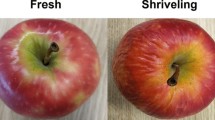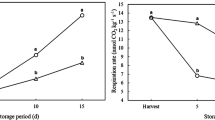Abstract
The effect of aqueous ozone at different doses on fungal incidence, microstructure, mechanical properties, and weight loss of blueberry fruit (Vaccinium corymbosum, cv. O’Neal) throughout 20 days of storage at 4 ± 1 °C was studied. Fruits were exposed to 10 and 18 mg O3 L-1 in a bubble column for different periods of time ranging from 10 to 30 min. Native mycobiota and Botrytis cinerea incidences were reduced by ozone exposure. After 15 days of storage, exposure to 18 mg O3 L-1 for 10 and 20 min reduced the percentage of infected fruit in ~ 34 and 40 %, respectively, when compared with untreated blueberries. Slight but no significant differences among ozone treatments were observed for native mycobiota and B. cinerea incidence. Stiffness, rupture force, and mechanical work required to break the fruit epidermis were not significantly affected by ozone treatments. The effect of ozone treatment on weight loss of blueberries was dose-dependent and was partially correlated with microstructural changes induced by ozone: disruptions in outer tangential and epidermal cell walls and alteration of the cuticle. Exposure times beyond 15 min significantly increased weight loss and did not achieve greater fungal inhibition with respect to 10- and 15-min ozonized fruit. Thus, the ozone dose to be selected would be limited by the negative effect on weight loss. Exposure to 18 mg O3 L-1 for 10 min would be the most suitable treatment to reduce fungal decay without causing an excessive loss of weight along cold storage.






Similar content being viewed by others
References
Argentinean Blueberry Committee (n.d.), Estadísticas. Hectáreas por región. https://www.argblueberry.com/home/estadisticas/. Accessed 14 Dic 2018.
Alexandre, E., Brandão, T., & Silva, C. (2012). Efficacy of non-thermal technologies and sanitizer solutions on microbial load reduction and quality retention of strawberries. Journal of Food Engineering, 108(3), 417–426.
Alexandre, E., Santos-Pedro, D., Brandão, T., & Silva, C. (2011). Influence of aqueous ozone, blanching and combined treatments on microbial load of red bell peppers, strawberries and watercress. Journal of Food Engineering, 105(2), 277–282.
Alwi, N. A., & Ali, A. (2015). Dose-dependent effect of ozone fumigation on physiological characteristics, ascorbic acid content and disease development on bell pepper (Capsicum annuum L.) during storage. Food and Bioprocess Technology, 8(3), 558–566.
Alzamora, S., Tapia, M. S., & López-Malo, F. (2000). Overview. In S. M. Alzamora, M. S. Tapia, & A. López-Malo (Eds.), Minimally processed fruits and vegetables (pp. 1–9). Maryland: EEUU Aspen Publishers Inc.
Alzamora, S. M., Viollaz, P. E., Martínez, V. Y., Nieto, A. B., & Salvatori, D. (2008). Exploring the linear viscoelastic properties structure relationship in processed fruit tissues. In G. F. Gutiérrez-López, G. V. Barbosa-Cánovas, J. Welti-Chanes, & E. Parada-Arias (Eds.), Food Engineering: Integrated Approaches (pp. 155–181). New York: EE.UU: Springer New York.
Bader, H., & Hoigné, J. (1982). Determination of ozone in water by the indigo method: a submitted standard method. Ozone Science and Engineering, 4(4), 169–176.
Bialka, K. L., & Demirci, A. (2007). Decontamination of Escherichia coli O157:H7 and Salmonella enterica on blueberries using ozone and pulsed UV-Light. Journal of Food Science, 72(9), M391–M396.
Brodowska, A. J., Nowak, A., & Śmigielski, K. (2018). Ozone in the food industry: principles of ozone treatment, mechanisms of action, and applications: an overview. Critical Reviews in Food Science and Nutrition, 58(13), 2176–2201.
Carpita, N. C., & Gibeaut, D. M. (1993). Structural models of primary cell walls in flowering plants: consistency of molecular structure with the physical properties of the walls during growth. The Plant Journal, 3(1), 1–30.
Concha-Meyer, A., Eifert, J. D., Williams, R. C., Marcy, J. E., & Welbaum, G. E. (2015). Shelf life determination of fresh blueberries (Vaccinium corymbosum) stored under controlled atmosphere and ozone. International Journal of Food Science, 2015, 9.
Contigiani, E. V., Jaramillo-Sánchez, G., Castro, M. A., Gómez, P. L., & Alzamora, S. M. (2018). Postharvest quality of strawberry fruit (Fragaria x Ananassa Duch cv. Albion) as affected by ozone washing: fungal spoilage, mechanical properties, and structure. Food and Bioprocess Technology, 11(9), 1639–1650.
Crisosto, C., Retzlaff, W., William, L., DeJong, T., & Zoffoli, J. (1993). Postharvest performance evaluation of plum (Prunus salicina Lindel., ‘Casselman’) fruit grown under three ozone concentrations. Journal of the American Society for Horticultural Science, 118(4), 497–502.
Chen, H., Cao, S., Fang, X., Mu, H., Yang, H., Wang, X., et al. (2015). Changes in fruit firmness, cell wall composition and cell wall degrading enzymes in postharvest blueberries during storage. Scientia Horticulturae, 188, 44–48.
Chu, W., Gao, H., Chen, H., Fang, X., & Zheng, Y. (2018). Effects of cuticular wax on the postharvest quality of blueberry fruit. Food Chemistry, 239, 68–74.
Chun, H. H., Kang, J. H., & Song, K. B. (2013). Effects of aqueous chlorine dioxide treatment and cold storage on microbial growth and quality of blueberries. Journal of Korean Society for Applied Biological Chemistry, 56(3), 309–315.
Duan, J., Wu, R., Strik, B. C., & Zhao, Y. (2011). Effect of edible coatings on the quality of fresh blueberries (Duke and Elliott) under commercial storage conditions. Postharvest Biology and Technology, 59(1), 71–79.
Duarte-Molina, F., Gómez, P. L., Castro, M. A., & Alzamora, S. M. (2016). Storage quality of strawberry fruit treated by pulsed light: fungal decay, water loss and mechanical properties. Innovative Food Science and Emerging Technologies, 34, 267–274.
Fava, J., Alzamora, S. M., & Castro, M. A. (2006). Structure and nanostructure of the outer tangential epidermal cell wall in Vaccinium corymbosum L. (blueberry) fruits by blanching, freezing-thawing and ultrasound. Food Science and Technology International, 12(3), 241–251.
Fava, J., Hodara, K., Nieto, A., Guerrero, S., Alzamora, S. M., & Castro, M. A. (2011). Structure (micro, ultra, nano), color and mechanical properties of Vitis labrusca L. (grape berry) fruits treated by hydrogen peroxide, UV–C irradiation and ultrasound. Food Research International, 44(9), 2938–2948.
Garcia Loredo, A. B., Guerrero, S. N., & Alzamora, S. M. (2015). Inactivation kinetics and growth dynamics during cold storage of Escherichia coli ATCC 11229, Listeria innocua ATCC 33090 and Saccharomyces cerevisiae KE162 in peach juice using aqueous ozone. Innovative Food Science and Emerging Technologies, 29, 271–279.
Giongo, L., Poncetta, P., Loretti, P., & Costa, F. (2013). Texture profiling of blueberries (Vaccinium spp.) during fruit development, ripening and storage. Postharvest Biology and Technology, 76, 34–39.
Greco, M., Patriarca, A., Terminiello, L., Fernández Pinto, V., & Pose, G. (2012). Toxigenic Alternaria species from Argentinean blueberries. International Journal of Food Microbiology, 154(3), 187–191.
Heredia, A. (2003). Biophysical and biochemical characteristics of cutin, a plant barrier biopolymer. Biochimica et Biophysica Acta (BBA), 1620(1), 1–7.
Horvitz, S., & Cantalejo, M. J. (2014). Application of ozone for the postharvest treatment of fruits and vegetables. Critical Reviews in Food Science and Nutrition, 54(3), 312–339.
Jackman, R. L., & Stanley, D. W. (1995). Perspectives in the textural evaluation of plant foods. Trends in Food Science and Technology, 6(6), 187–194.
Järvinen, R., Kaimainen, M., & Kallio, H. (2010). Cutin composition of selected northern berries and seeds. Food Chemistry, 122(1), 137–144.
Jeffree, C. E. (2006). The fine structure of the plant cuticle. In Riederer, M., & Muller, C. (Eds.), Biology of the plant cuticle, Vol. 23 (, pp. 11-125). Germany: Blackwell Publishing.
Kim, C., & Hung, Y. (2012). Inactivation of E. coli O157:H7 on blueberries by electrolyzed water, ultraviolet light, and ozone. Journal of Food Science, 77(4), M206–M211.
Konarska, A. (2015a). Development of fruit quality traits and comparison of the fruit structure of two Vaccinium corymbosum (L.) cultivars. Scientia Horticulturae, 194, 79–90.
Konarska, A. (2015b). Morphological, anatomical, and ultrastructural changes in Vaccinium corymbosum fruits during ontogeny. Botany, 93(9), 589–602.
Lara, I., Belge, B., & Goulao, L. F. (2014). The fruit cuticle as a modulator of postharvest quality. Postharvest Biology and Technology, 87, 103–112.
Lyshede, O. B. (1982). Structure of the outer epidermal wall in xerophytes. In D. F. Cutler, K. L. Alvin, & C. E. Price (Eds.), The plant cuticle (pp. 87–98). London: Academic Press.
Mengiste, T., Laluk, K., & AbuQamar, S. (2010). Mechanisms of induced resistance against B. cinerea. In D. Prusky & M. Gullino (Eds.), Postharvest Pathology (pp. 13–30). Dordrecht: Springer Netherlands.
Misra, N. N., Moiseev, T., Patil, S., Pankaj, S. K., Bourke, P., Mosnier, J. P., et al. (2014). Cold plasma in modified atmospheres for post-harvest treatment of strawberries. Food and Bioprocess Technology, 7(10), 3045–3054.
Moggia, C., Graell, J., Lara, I., Schmeda-Hirschmann, G., Thomas-Valdés, S., & Lobos, G. A. (2016). Fruit characteristics and cuticle triterpenes as related to postharvest quality of highbush blueberries. Scientia Horticulturae, 211, 449–457.
Muthukumarappan, K., Halaweish, F., & Naidu, A. (2000). Ozone. In A. S. Naidu (Ed.), Natural Food Antimicrobial Systems (pp. 783–800). New York: CRC/ Press.
Muthukumarappan, K., Tiwari, B., O’Donnell, C. P., & Cullen, P. (2016). Ozone and CO2 processing: rheological and functional properties of food. In J. Ahmed, H. Ramaswamy, S. Kasapis, & J. Boye (Eds.), Novel Food Processing: Effects on Rheological and Functional Properties (pp. 127–146). New York, EE.UU: CRC/ Press, Taylor y Francis Group.
Ong, M. K., Kazi, F. K., Forney, C. F., & Ali, A. (2013). Effect of gaseous ozone on papaya anthracnose. Food and Bioprocess Technology, 6(11), 2996–3005.
Palou, L., Crisosto, C., Smilanick, J., Adaskaveg, J., & Zoffoli, J. (2002). Effects of continuous 0.3 ppm ozone exposure on decay development and physiological responses of peaches and table grapes in cold storage. Postharvest Biology and Technology, 24(1), 39–48.
Pangloli, P., & Hung, Y. (2013). Reducing microbiological safety risk on blueberries through innovative washing technologies. Food Control, 32(2), 621–625.
Piechowiak, T., Antos, P., Józefczyk, R., Kosowski, P., Skrobacz, K., & Balawejder, M. (2018). Impact of ozonation process on the microbiological contamination and antioxidant capacity of highbush blueberry (Vaccinum corymbosum L.) fruit during cold storage (pp 1-10). Ozone: Science and Engineering.
R Development Core Team. (2014). R: A language and environment for statistical computing. R foundation for statistical computing, Wien, Austria. http://www.R-proyect.org.
Rakness, K., Gordon, G., Langlais, B., Masschelein, W., Matsumoto, N., Richard, Y., et al. (1996). Guideline for measurement of ozone concentration in the process gas from an ozone generator. Ozone Science and Engineering, 18(3), 209–229.
Sandermann, H., Ernst, D., Heller, W., & Langebartels, C. (1998). Ozone: an abiotic elicitor of plant defence reactions. Trends in Plant Science, 3(2), 47–50.
Schreiber, L., & Schonherr, J. (2009). Water and solute permeability of plant cuticles (4th ed.). Berlin: Springer.
Skurtys, O., Velásquez, P., Henriquez, O., Matiacevich, S., Enrione, J., & Osorio, F. (2011). Wetting behavior of chitosan solutions on blueberry epicarp with or without epicuticular waxes. LWT - Food Science and Technology, 44(6), 1449–1457.
Tzortzakis, N., Borland, A., Singleton, I., & Barnes, J. (2007). Impact of atmospheric ozone-enrichment on quality-related attributes of tomato fruit. Postharvest Biology and Technology, 45(3), 317–325.
Vicente, A. R., Ortugno, C., Rosli, H., Powell, A. L. T., Greve, L. C., & Labavitch, J. M. (2007). Temporal sequence of cell wall disassembly events in developing fruits. 2. analysis of blueberry (Vaccinium species). Journal of Agricultural and Food Chemistry, 55(10), 4125–4130.
Wang, Y., Hollingsworth, R. I., & Kasper, D. L. (1999). Ozonolytic depolymerization of polysaccharides in aqueous solution. Carbohydrate Research, 319(1-4), 141–147.
Xu, F., & Liu, S. (2017). Control of postharvest quality in blueberry fruit by combined 1-methylcyclopropene (1-MCP) and UV-C irradiation. Food and Bioprocess Technology, 10(9), 1695–1703.
Funding
The authors would like to acknowledge the financial support from Universidad de Buenos Aires (UBACYT 2014-7 Project 20020130100388BA), Consejo Nacional de Investigaciones Científicas y Técnicas (CONICET) and Agencia Nacional de Promoción Científica y Tecnológica (ANPCyT) of Argentina and from Banco Interamericano de Desarrollo (BID), and SENESCYT from Ecuador.
Author information
Authors and Affiliations
Corresponding author
Additional information
Publisher’s Note
Springer Nature remains neutral with regard to jurisdictional claims in published maps and institutional affiliations.
Rights and permissions
About this article
Cite this article
Jaramillo-Sánchez, G., Contigiani, E.V., Castro, M. et al. Freshness Maintenance of Blueberries (Vaccinium corymbosum L.) During Postharvest Using Ozone in Aqueous Phase: Microbiological, Structure, and Mechanical issues. Food Bioprocess Technol 12, 2136–2147 (2019). https://doi.org/10.1007/s11947-019-02358-z
Received:
Accepted:
Published:
Issue Date:
DOI: https://doi.org/10.1007/s11947-019-02358-z




